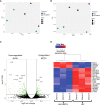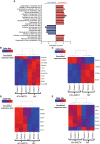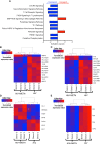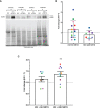Methamphetamine induces transcriptional changes in cultured HIV-infected mature monocytes that may contribute to HIV neuropathogenesis
- PMID: 36059515
- PMCID: PMC9433802
- DOI: 10.3389/fimmu.2022.952183
Methamphetamine induces transcriptional changes in cultured HIV-infected mature monocytes that may contribute to HIV neuropathogenesis
Abstract
HIV-associated neurocognitive impairment (HIV-NCI) persists in 15-40% of people with HIV (PWH) despite effective antiretroviral therapy. HIV-NCI significantly impacts quality of life, and there is currently no effective treatment for it. The development of HIV-NCI is complex and is mediated, in part, by the entry of HIV-infected mature monocytes into the central nervous system (CNS). Once in the CNS, these cells release inflammatory mediators that lead to neuroinflammation, and subsequent neuronal damage. Infected monocytes may infect other CNS cells as well as differentiate into macrophages, thus contributing to viral reservoirs and chronic neuroinflammation. Substance use disorders in PWH, including the use of methamphetamine (meth), can exacerbate HIV neuropathogenesis. We characterized the effects of meth on the transcriptional profile of HIV-infected mature monocytes using RNA-sequencing. We found that meth mediated an upregulation of gene transcripts related to viral infection, cell adhesion, cytoskeletal arrangement, and extracellular matrix remodeling. We also identified downregulation of several gene transcripts involved in pathogen recognition, antigen presentation, and oxidative phosphorylation pathways. These transcriptomic changes suggest that meth increases the infiltration of mature monocytes that have a migratory phenotype into the CNS, contributing to dysregulated inflammatory responses and viral reservoir establishment and persistence, both of which contribute to neuronal damage. Overall, our results highlight potential molecules that may be targeted for therapy to limit the effects of meth on HIV neuropathogenesis.
Keywords: HIV; methamphetamine; migration; monocytes; neuroinflammation; viral reservoirs.
Copyright © 2022 Chilunda, Weiselberg, Martinez-Meza, Mhamilawa, Cheney and Berman.
Conflict of interest statement
The authors declare that the research was conducted in the absence of any commercial or financial relationships that could be construed as a potential conflict of interest.
Figures






Similar articles
-
The impact of substance abuse on HIV-mediated neuropathogenesis in the current ART era.Brain Res. 2019 Dec 1;1724:146426. doi: 10.1016/j.brainres.2019.146426. Epub 2019 Aug 29. Brain Res. 2019. PMID: 31473221 Free PMC article. Review.
-
Mechanisms of CNS Viral Seeding by HIV+ CD14+ CD16+ Monocytes: Establishment and Reseeding of Viral Reservoirs Contributing to HIV-Associated Neurocognitive Disorders.mBio. 2017 Oct 24;8(5):e01280-17. doi: 10.1128/mBio.01280-17. mBio. 2017. PMID: 29066542 Free PMC article.
-
Monocytes mediate HIV neuropathogenesis: mechanisms that contribute to HIV associated neurocognitive disorders.Curr HIV Res. 2014;12(2):85-96. doi: 10.2174/1570162x12666140526114526. Curr HIV Res. 2014. PMID: 24862333 Free PMC article. Review.
-
Methamphetamine Dysregulates Macrophage Functions and Autophagy to Mediate HIV Neuropathogenesis.Biomedicines. 2022 May 27;10(6):1257. doi: 10.3390/biomedicines10061257. Biomedicines. 2022. PMID: 35740279 Free PMC article.
-
Dopamine increases CD14+CD16+ monocyte migration and adhesion in the context of substance abuse and HIV neuropathogenesis.PLoS One. 2015 Feb 3;10(2):e0117450. doi: 10.1371/journal.pone.0117450. eCollection 2015. PLoS One. 2015. PMID: 25647501 Free PMC article.
Cited by
-
Differential expression profiling of tRNA-Derived small RNAs and their potential roles in methamphetamine self-administered rats.Front Genet. 2023 Feb 2;14:1088498. doi: 10.3389/fgene.2023.1088498. eCollection 2023. Front Genet. 2023. PMID: 36845381 Free PMC article.
-
Dysfunction of the Neurovascular Unit by Psychostimulant Drugs.Int J Mol Sci. 2023 Oct 13;24(20):15154. doi: 10.3390/ijms242015154. Int J Mol Sci. 2023. PMID: 37894832 Free PMC article. Review.
-
Methamphetamine and HIV-1 Tat Synergistically Induce Microglial Pyroptosis Via Activation of the AIM2 Inflammasome.Inflammation. 2025 Feb 19. doi: 10.1007/s10753-025-02266-9. Online ahead of print. Inflammation. 2025. PMID: 39969742
-
Decreasing β-Catenin Leads to Altered Endothelial Morphology, Increased Barrier Permeability and Cognitive Impairment During Chronic Methamphetamine Exposure.Int J Mol Sci. 2025 Feb 11;26(4):1514. doi: 10.3390/ijms26041514. Int J Mol Sci. 2025. PMID: 40003980 Free PMC article.
-
The interaction between central and peripheral immune systems in methamphetamine use disorder: current status and future directions.J Neuroinflammation. 2025 Feb 15;22(1):40. doi: 10.1186/s12974-025-03372-z. J Neuroinflammation. 2025. PMID: 39955589 Free PMC article. Review.
References
-
- UNAIDS . Global HIV & AIDS statistics — fact sheet 2022 [cited 2022 march 27th]. Available at: https://www.unaids.org/en/resources/fact-sheet
Publication types
MeSH terms
Substances
Grants and funding
LinkOut - more resources
Full Text Sources
Medical
Molecular Biology Databases

